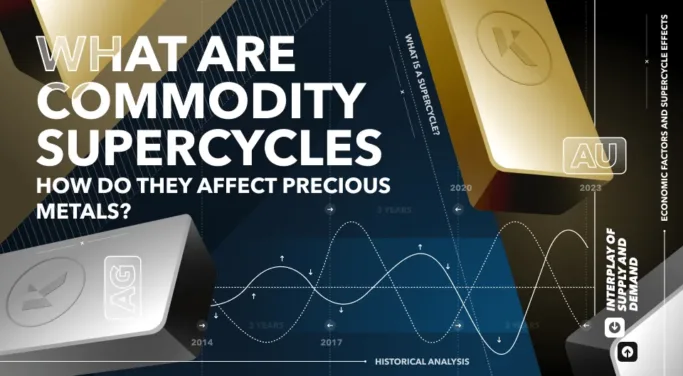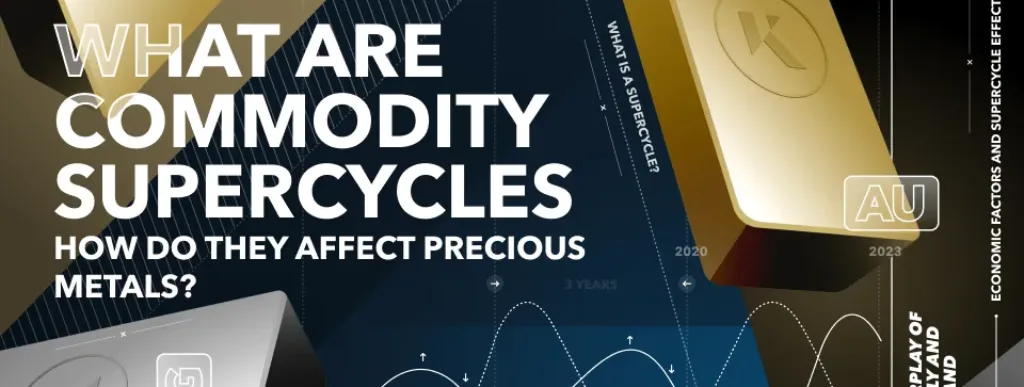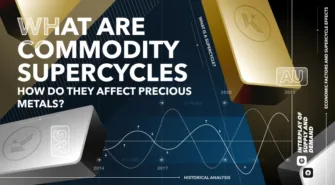Commodity supercycles have been moving through history in cyclical patterns since the nineteenth century.
These long-term movements in commodity prices are affected by a multitude of factors such as: economic growth, rapid industrial developments and post-war economic reconstruction.
We’ll study the relationship between precious metals and the interesting phenomenon of commodity supercycles and examine the cause. How do these supercycles affect the market? And why do they have such a profound influence on the prices of gold and silver?
We’ll also take a look at the landscape of commodities, exploring how trends in resources can have a ripple effect on the prices of precious metals. With a focus on the world of gold and silver, we will discuss how commodity supercycles are influenced by key factors such as global demand and supply dynamics, inflation, and economic growth.
What is a Supercycle?
So, what exactly is a Supercycle? A commodity Supercycle is an extended period, often spanning decades, during which commodity demand consistently increases. This rise in demand for commodities such as energy, metals and precious metals, agricultural raw material and other basic goods result in a constant and steady upward trajectory in commodity prices.
These supercycles are typically driven by a combination of factors such as increased global demand, supply constraints, and macroeconomic dynamics.
Historical Analysis: Precious Metals and Supercycles
It is important to examine the historical context of precious metals within these periods of increased demand. Throughout history, gold and silver have followed the flow of commodity supercycles, their prices influenced by the tides of economic and market forces.
For example, a major supercycle for gold began its rise in 2001, when gold prices stood around $250 per ounce. By 2011, it had grown to more than $1,800 an ounce. In the space of ten years, the price had risen around 620%. This reflects the influence of the supercycle driven by China’s rapid economic growth and its elevation to the World Trade Organisation.
Silver followed a similar pattern at that time, with a huge rise from $3.6 per ounce in 2001 to almost $36 per ounce in the same 10-year time frame in 2011.
Looking at the history of the price of silver, precious metals analyst Rupert Rowling observed the volatility of silver over time:
“Silver achieved its record price of $49.48 an ounce in 1980 and came close to breaking that level in 2011. However, that price spike soon reversed with the price plunging below $35 an ounce in a matter of weeks.”
It shows, however, how influences such as commodity supercycles can greatly affect the value of precious metals and lead to huge surges in price.
Read more on a Gold & Silver outlook and forecast for November 2023
Economic Factors and Supercycle Effects
Economic factors play a pivotal role in the dynamics of supercycles and, in turn, their effects on precious metals. These economic factors influence the performance and health of the economy. Here are some examples:
- Inflation – the price of commodities such as oil can strengthen inflation which then leads to an increase in the price of other goods.
- GDP (Gross Domestic Product) measures the value of final goods or services
- Interest rates.
- Government Policies.
- Unemployment rates.
- Global Trade – exports and imports.
These factors can significantly impact the prices of gold and silver, making them an essential asset class for investors looking to navigate these complex landscapes.
Interplay of Supply and Demand
Supply and demand dynamics are the core of commodity supercycles.
When considering precious metals such as gold and silver, understanding the interplay between these factors is critical.
Shifts in global demand for these metals, often driven by their use in various industries, jewellery, and as an investment, can affect their prices. Additionally, the role of supply constraints, including mining output and geopolitical influences, also shape the trajectory of these metals.
Meeting the equilibrium price shows an agreement between the producers and consumers of a particular good. It is when supply quantity and demand quantity are equal. When demand increases or supply reduces, the prices are typically forced up.
Demand Growth for Precious Metals
The demand for precious metals during a supercycle is due to several factors:
- Supercycles can lead to surges in demand for gold and silver, both as safe-haven assets and as stores of value in times of economic uncertainty.
- This heightened demand can exert upward pressure on their prices, making them a sought-after choice for investors looking to safeguard their wealth.
Gold & Silver in the supercycle landscape
These metals have proven time and again to be not only stores of value but also dynamic assets that respond to global economic shifts.
Gold and silver benefit from supercycle landscapes as they play such a large role in the global economy.
Gold provides:
- A safe haven asset that stores value
- An inflation hedge – used to preserve purchasing power
- A key raw material to jewellery industry
Silver provides:
- An important raw material for various industries
- An investment asset and inflation hedge
- A store of value at uncertain times
As we experience repeated supercycles, it’s important to understand their intricacies, the interplay of economic factors and the supply and demand dynamics. Investors seeking to harness the potential of these enduring and desirable assets often monitor market uptrends to help predict if a commodity supercycle may be on its way.
In a system of ever-evolving economic forces, grasping the impact of commodity supercycles on precious metals is a powerful tool for investors looking to make informed decisions and secure their financial future.
For more insights into the world of commodities and the precious metals market, visit Kinesis and see how you can protect and grow your wealth using gold and silver as money.
Carlo is an external market analyst for Kinesis Money. With a credential background in Economic Finance and International Exchange (MA), Carlo’s critical analysis of gold and silver markets’ performance is frequently quoted by leading publications such as Forbes, Reuters, CNBC, and Nasdaq.
This publication is for informational purposes only and is not intended to be a solicitation, offering or recommendation of any security, commodity, derivative, investment management service or advisory service and is not commodity trading advice. This publication does not intend to provide investment, tax or legal advice on either a general or specific basis.
Read our Editorial Guidelines here.
















